Swiss cheese plant care and growing tips: expert plant advice
Swiss cheese plants are very much the darlings of the current houseplant craze. Here's what you need to know about Monstera deliciosa
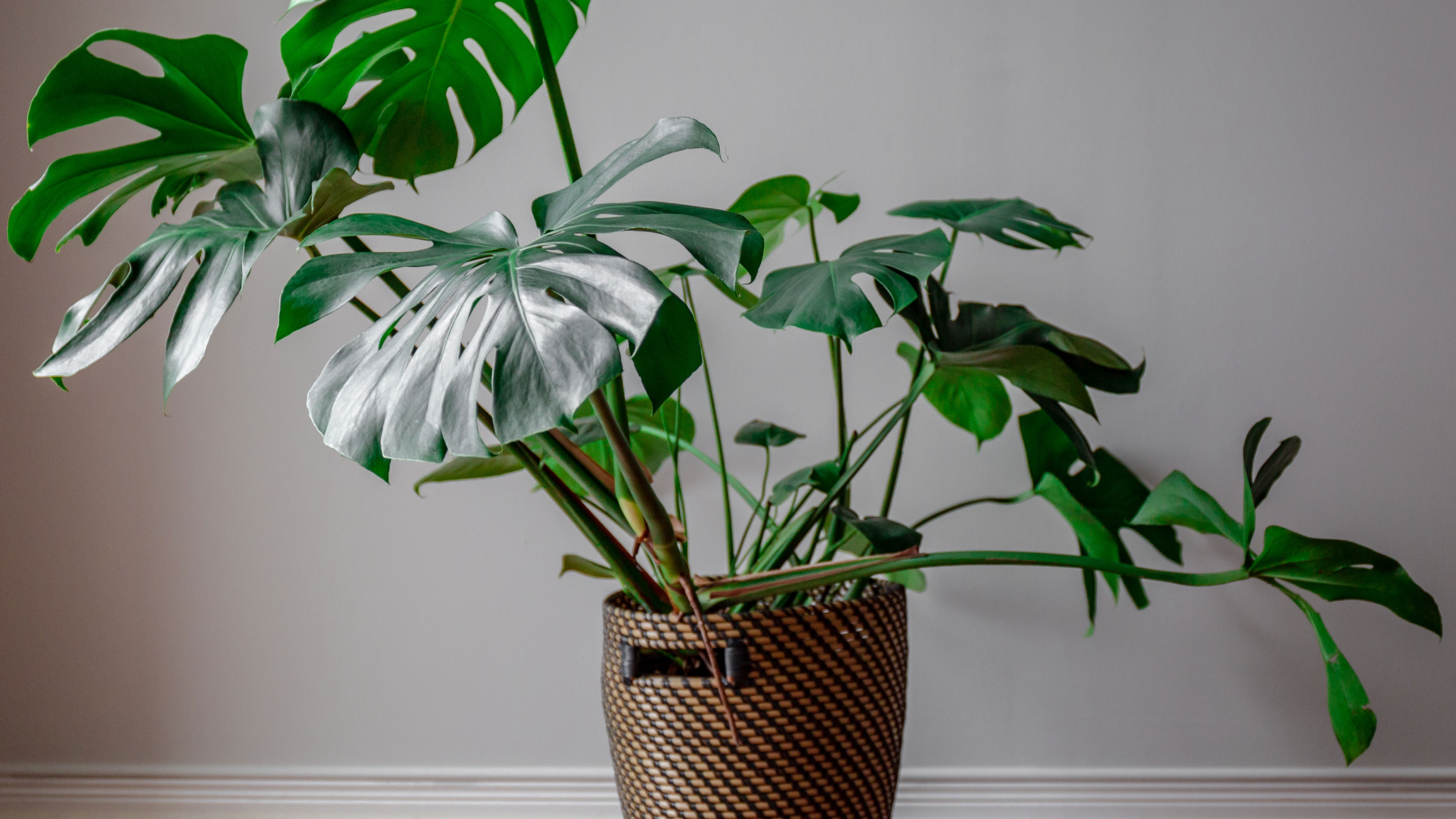

With its dramatic large scale foliage and glossy good looks, 1970s favorite the Swiss cheese plant is having a moment that's put it firmly back in the spotlight. A big part of the appeal lies in the glossy serrated leaves, which are known as 'fenestrated' because of the perforations.
Swiss cheese plants are perfect if you want an impressive but low-maintenance houseplant that makes waves on social media. You may have seen references to 'Monstera Monday' in Insta posts. Swiss cheese plants are also known as Monstera deliciosa, which is their botanical name.
If you're looking for one of the best indoor plants to create stunning displays, make sure the Swiss cheese plant is a feature. In terms of adding interest to your home with a bold architectural plant you can't beat them.
Even though they’re super easy to grow make sure you max up your plant’s potential by following our expert Swiss cheese plant care tips. They are low maintenance and rewarding plants as long as you remember a few key things.

Selection of on-trend houseplants from Dobbies including a Swiss cheese plant (centre)
3 top tips for Swiss cheese plant care
From where to position one to how often to water it plus more, we’ve rounded up all the expert tips you need on Swiss cheese plant care so you can get the most from your stunning Monstera deliciosa.
‘If you’re looking for a spectacular plant that can survive without much effort, a Swiss cheese plant is ideal for beginners and experienced plant parents alike,’ says Patch Plant’s Plant Doctor Richard Cheshire.
Here are the key things you need to know to ensure this houseplant favorite takes center stage in your indoor garden ideas.
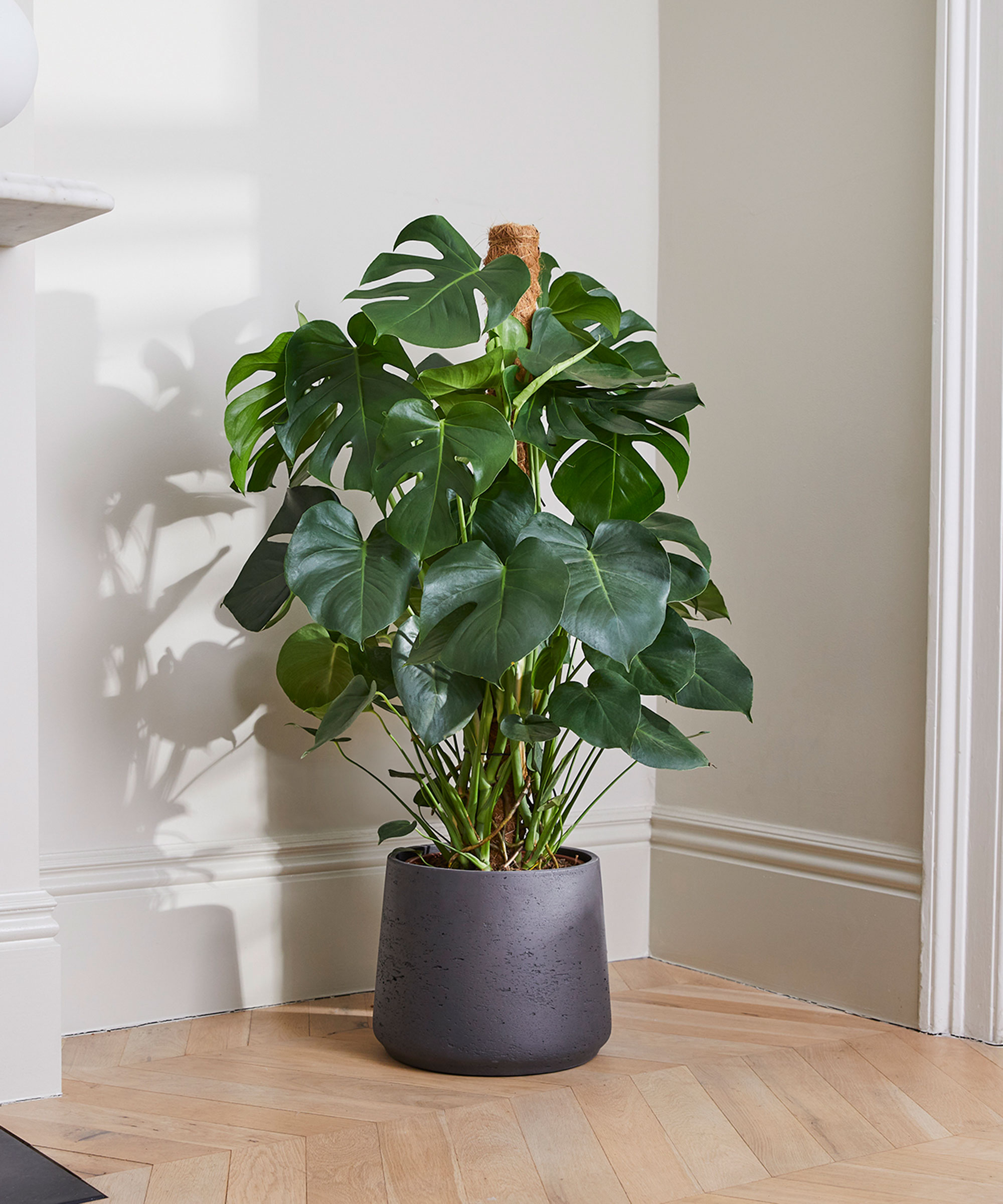
'He’s a classic with loads of personality,' say the experts at Patch Plants on their Swiss cheese plant. 'He’s really easy to look after and makes a style statement wherever you put him'
1. Don't overwater them
Swiss cheese plants are happiest when allowed to dry out a bit. Watering plants when the surface of the soil is almost completely dry is what's best for them. When they do need watering add a trickle of water until the excess runs out of the bottom of the pot then tip it away.
‘Make sure the pot has plenty of drainage holes in the bottom. Your Swiss cheese plant won’t thank you if they end up with soggy, rotting roots,’ says Richard.
This is a good tip for other indoor plants too, as it's never a good idea to let the roots of your plants become waterlogged.

2. Choose the right spot
Being used to the dark jungle floor, the Swiss cheese plant can thrive in a range of light conditions. Bright, indirect light is ideal if you want to include one of these in your indoor plant ideas, but not harsh sunlight.
‘An ideal spot is somewhere with plenty of medium light, but avoid direct sunlight as it could burn the leaves,’ says Richard. ‘The distinctive cut-out patterns on their leaves won't develop either if it’s too dark.’
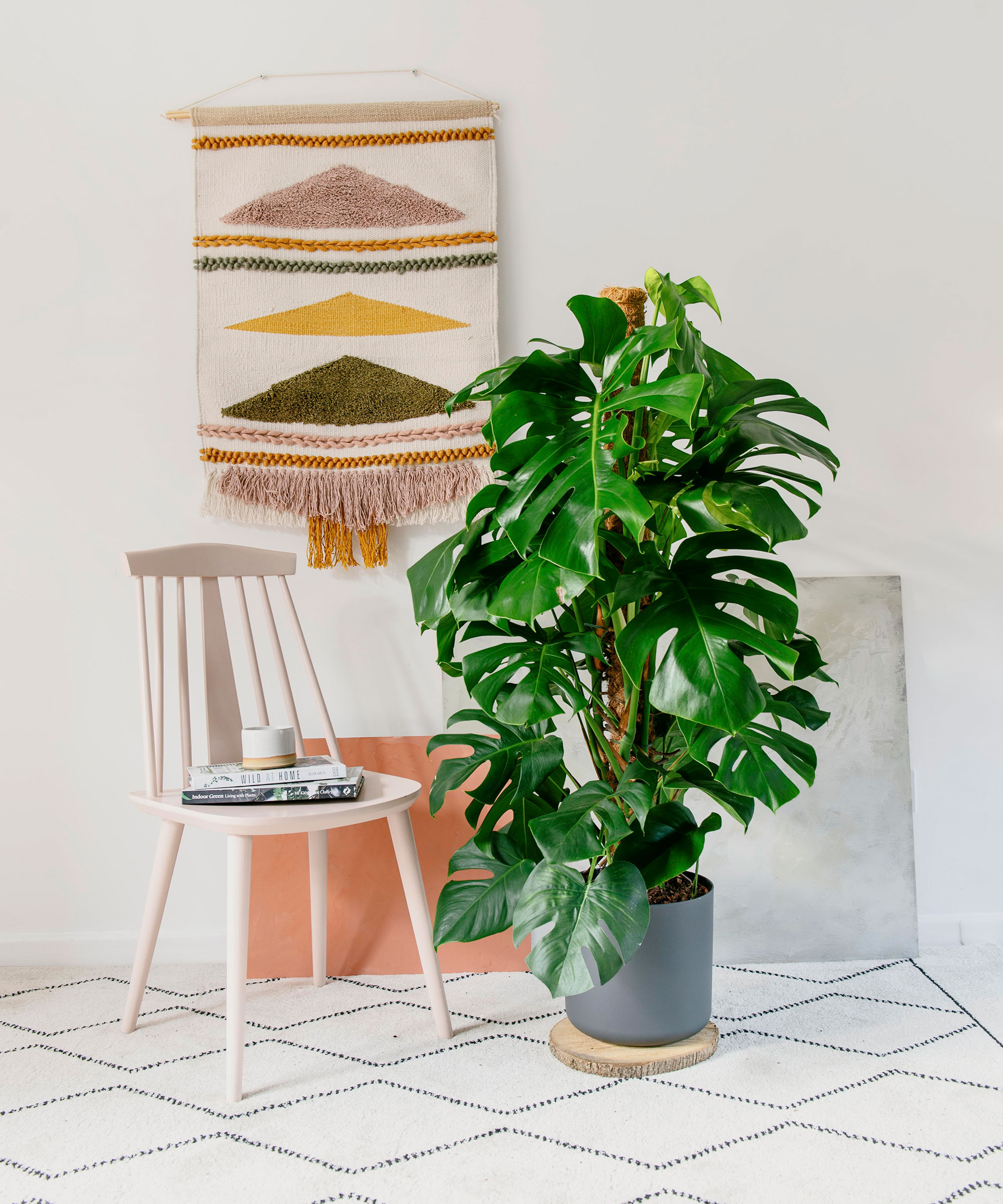
'Swiss cheese plants need plenty of space and benefit from support as they grow larger,' say the experts at Beards & Daisies
3. Make sure the temperature’s right
Swiss cheese plants usually live in tropical regions, so they prefer moderate to high temperatures. ‘Anywhere between 59-86˚F (15-30˚C) is fine,’ says Richard.
‘Swiss cheese plants aren’t fans of dry air or cold breezes either, so avoid areas near drafty windows or radiators. They do, however, love humidity. Mist their leaves every few days to keep them perky.'
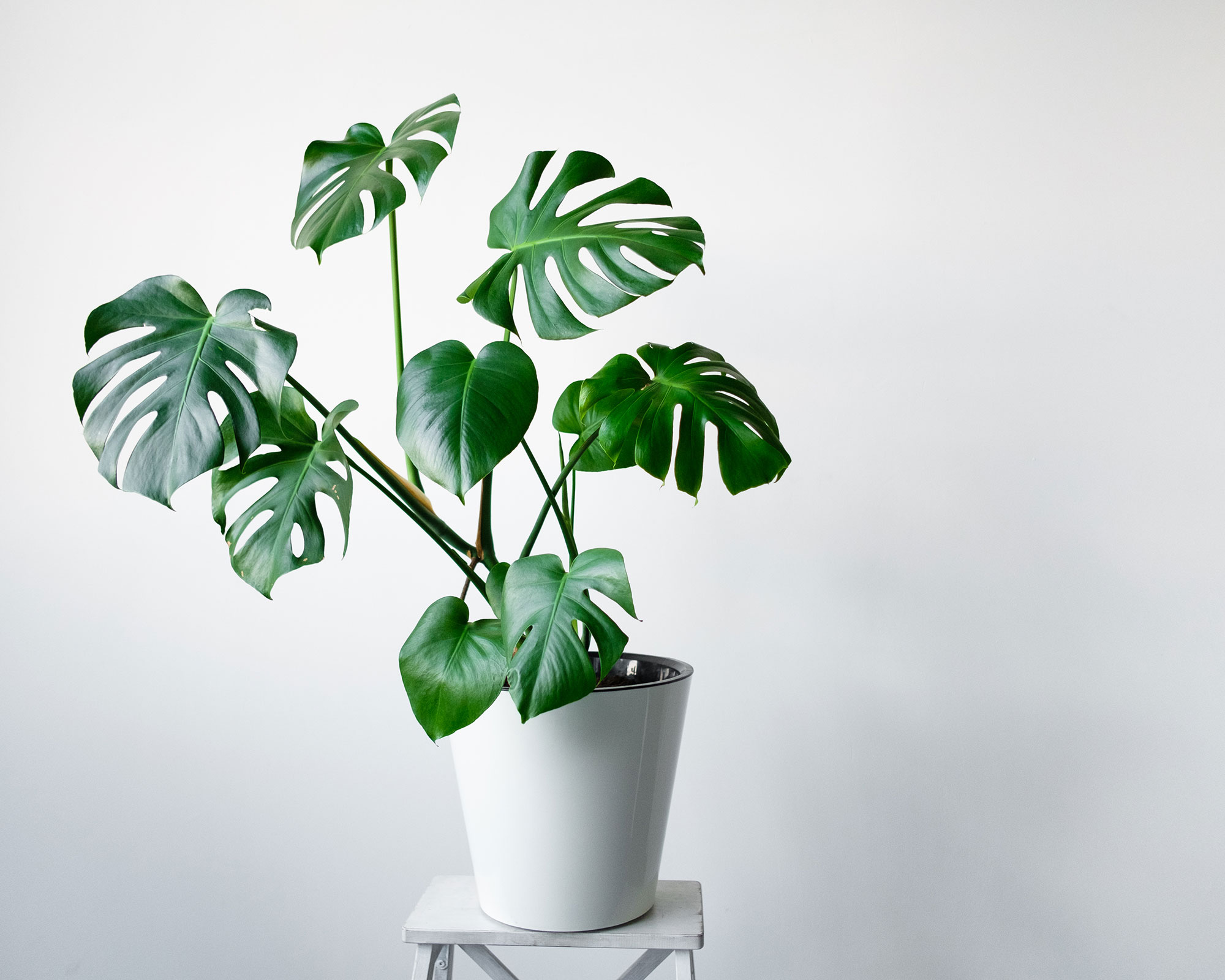
What is the difference between a Swiss cheese plant and a Monstera?
A Swiss cheese plant is a type of Monstera plant. 'There are around 45 species of this genus of plants – all are known and loved for their beautiful foliage and creeping vines,' says Jo Lambell, founder of houseplant specialists Beards & Daisies.
'The Swiss cheese plant is technically called Monstera deliciosa – the deliciosa part refers to the fruit can produce in the wild, which if you haven’t guessed, is delicious!'
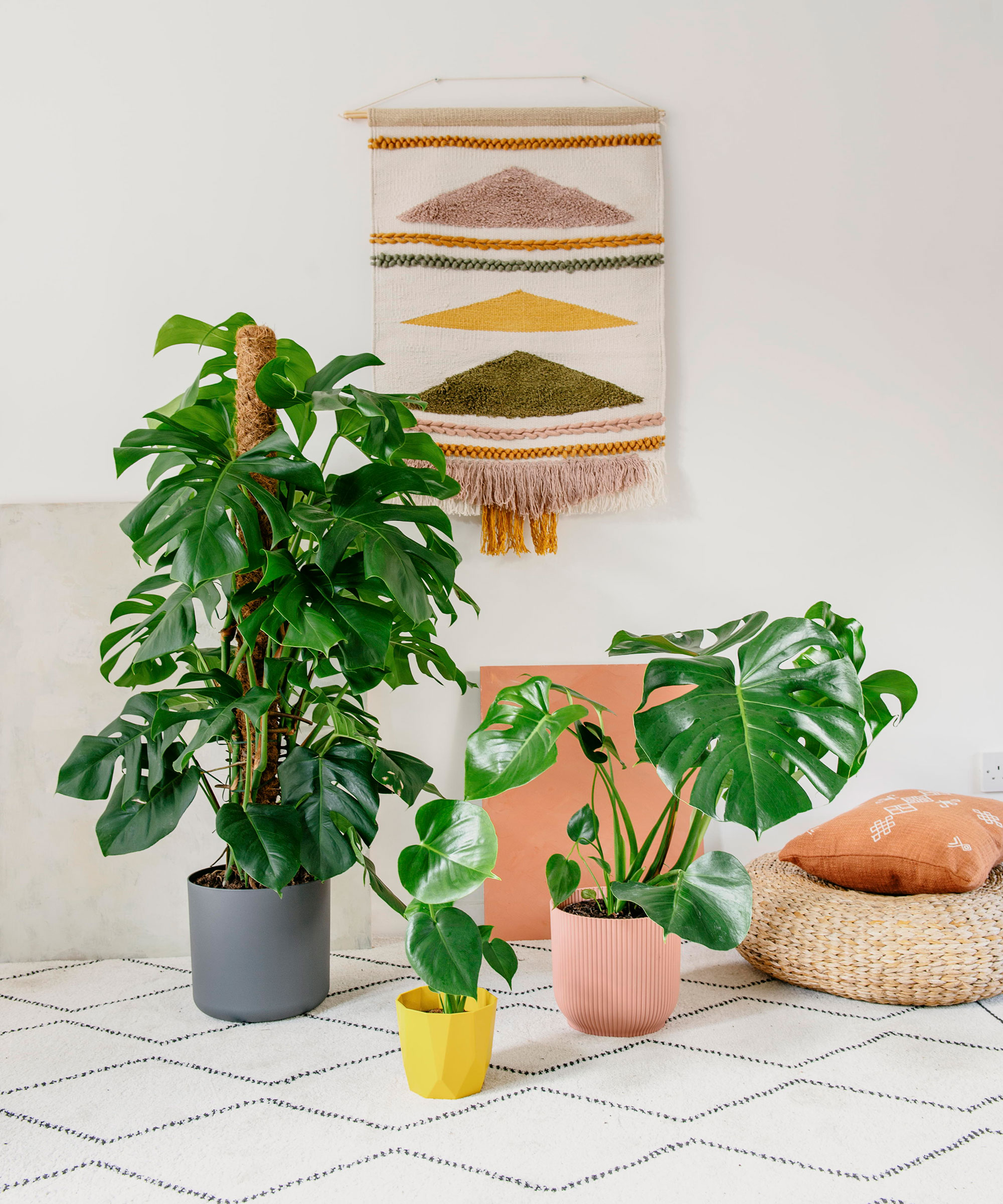
'This plant has tendril like aerial roots meaning they will be visible above the surface and can be fed into a moss pole,' say Beards & Daisies
How do I keep my Swiss cheese plant healthy?
Even though they are one of the best plants for beginners, Swiss cheese plants are happiest with some easy regular maintenance. Keep their leaves free of dust using a clean, damp cloth occasionally. Misting leaves also helps keep them free of dust.
'Just make sure you provide your Swiss cheese plant with plenty of room, as big leaves demand big spaces,' says Jo Lambell. 'This plant will appreciate having room to grow.'
You could consider giving it a supportive pole as it gets increasingly bigger. If your Monstera deliciosa plant starts to spread so much that it droops it's nothing to worry about but try using a moss pole (available from Amazon) to stake it so you can keep it upright.
You can give your Swiss cheese plant a growing boost in spring and summer with some liquid fertilizer. Apply this once a month to get the best results.
The Swiss cheese plant has health benefits for you too as it's a great air purifying plant, so will help to clean the air in your home. And if you're interested in other houseplants with health benefits, it's worth learning about aloe vera plant care so you can make the most of this indoor plant's medicinal properties.

Monstera plant from a selection at Dobbies
How often do you need to repot a Swiss cheese plant?
If you keep them happy, Swiss cheese plants will grow quite quickly. They’ll also grow little white roots from their stems that help them grip. You can lop these off without harming them.
You'll need a sturdy pot to keep up with growth spurts. Your Swiss cheese plant needs a bigger home when the roots start to jut out from the nursery pot. ‘These plants grow fast and will need repotting every two years,’ says plant expert Sarah Raven.
If you want best results with how to repot a plant, our advice is to repot Mostera deliciosa in spring using a good multi-purpose compost.

'The Swiss cheese plant is a climber originating from tropical forests in Central America but seems perfectly happy in our homes,' says Sarah Raven
How often should you water a Swiss cheese plant?
'Ideally, you should water your Swiss cheese plant every two to four weeks, using a skewer to test how dry the soil is. If it's wet, hold off on watering,' says the experts at The Greenhouse People.
You will want to ensure that the top 2in (5cm) is dry before watering again. It is also important to ensure that the pot has adequate drainage, and the roots are not submerged in water.
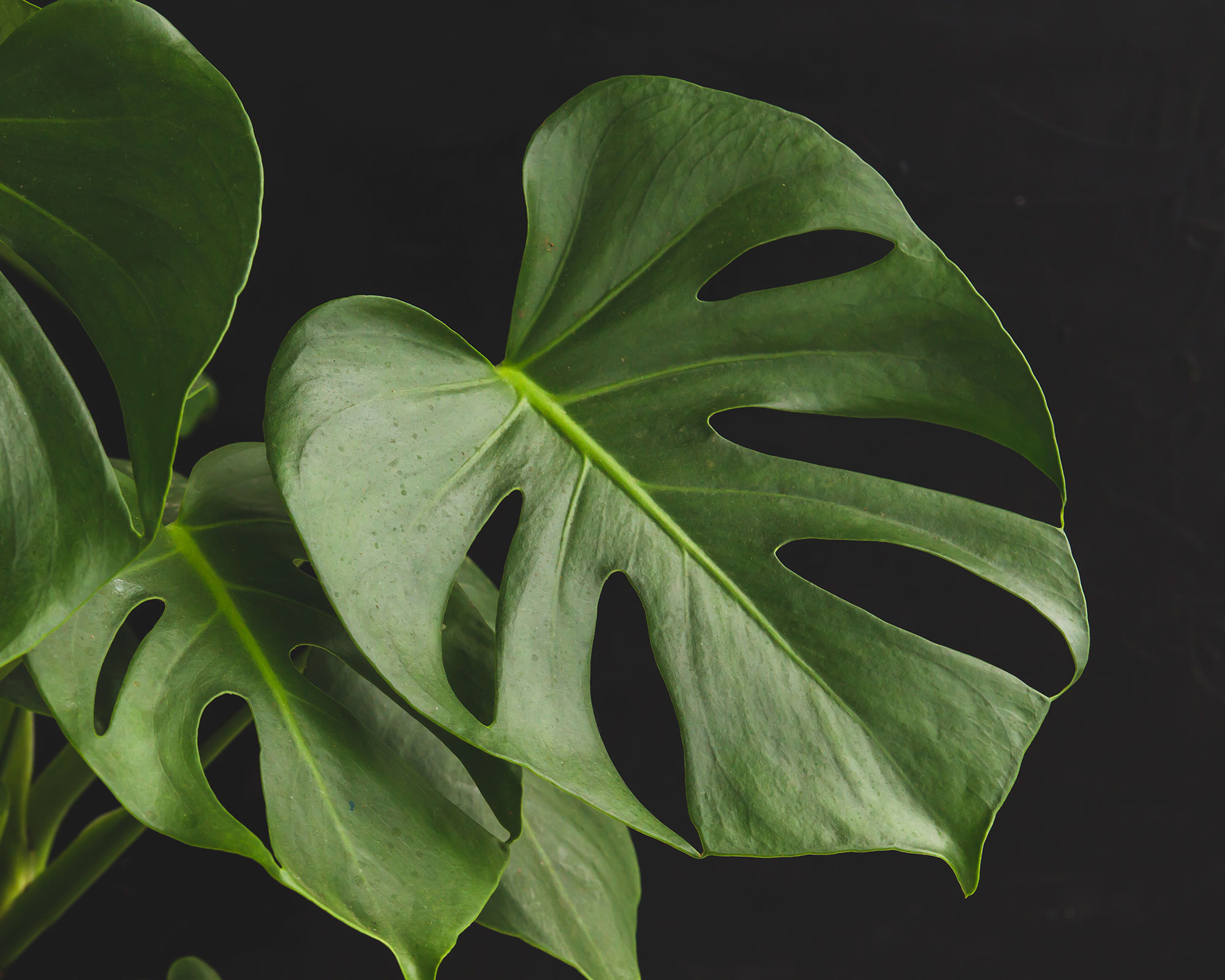
Are Swiss cheese plants easy to keep alive?
Swiss cheese plants are easy to look after and one of the best low maintenance indoor plants you can grow.
'Swiss cheese plants are one of the easiest houseplants to look after and have recently had a revival in fashion due to their ease of growing as well as their unique, yet beautiful, leaf formations,' says Miracle-Gro gardening guru Kate Turner.
Here are Kate's essential care tips:
- Place your Swiss cheese plant in a bright, draft-free spot but away from direct sunlight.
- Avoid overwatering by only watering the plant with room temperature water when the top two inches of the soil is dry.
- Feed fortnightly from spring to early autumn with an all-purpose feed.
- Provide a moss pole for the leaves to climb up and spray with a mister once a week during the growing season.
- Occasionally dust the leaves to enable the light to penetrate. This is especially important during the winter months.
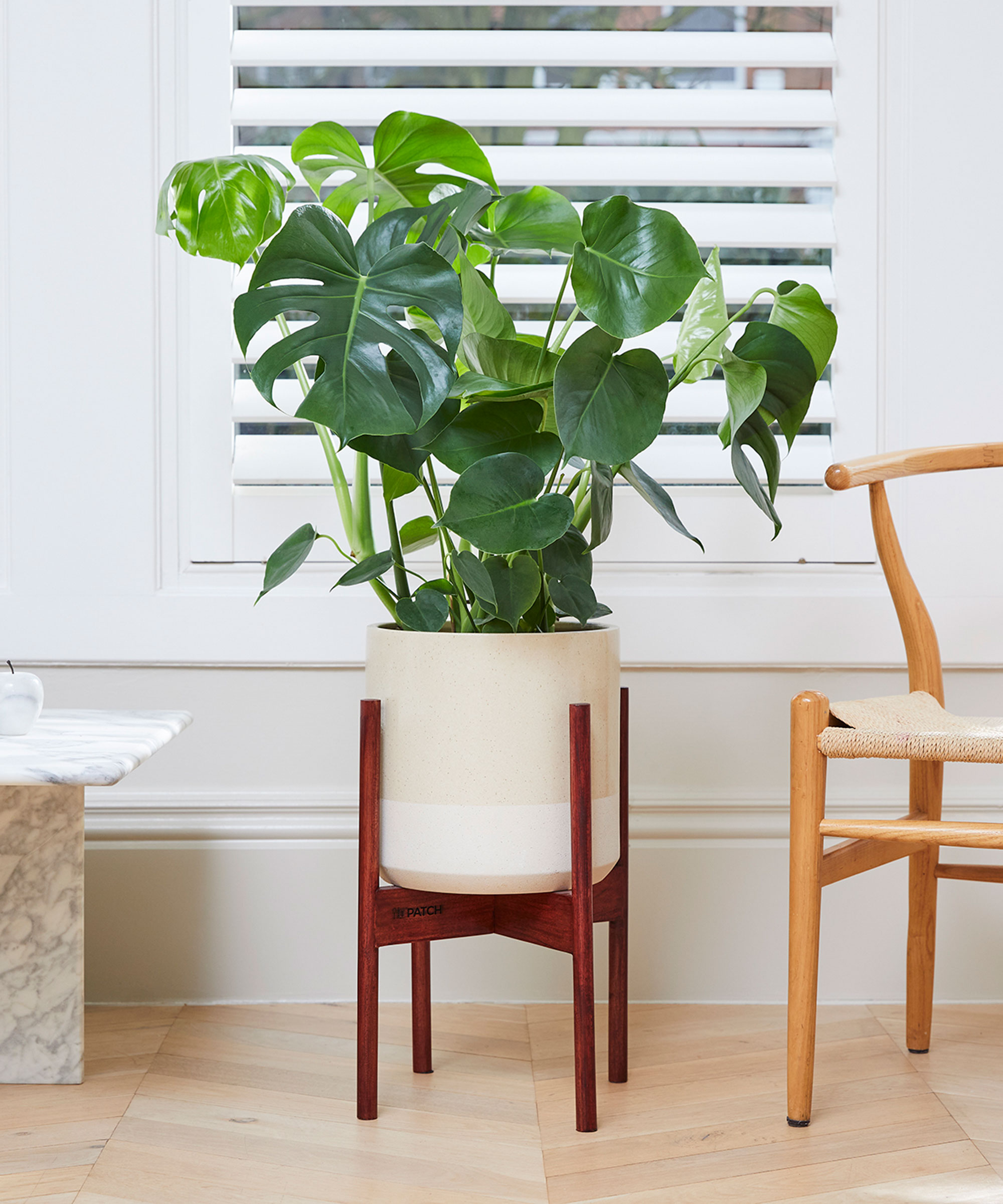
Swiss cheese plant pot and stand from Patch Plants
Why are the tips of my Swiss cheese plant turning brown?
Swiss cheese plants prefer medium indirect light, and their ends may turn brown and crispy if they are placed in too much direct sunlight.
'Browning leaves can also indicate your plant is suffering from low humidity,' says Leaf Envy founder Beth Chapman, who puts Swiss cheese plants high on her list of favorites. Moving it to a steamy bathroom should help.
You'll find more of the best plants for bathrooms in our dedicated guide.
What conditions do Swiss cheese plants like?
'Swiss cheese plants thrive in a humid environment which can be tricky to achieve, particularly in winter,' say the experts at The Greenhouse People. 'If you are really dedicated to your plants, consider purchasing a humidifier. Alternatively, place your monstera in your bathroom where there is more moisture in the air.'
Leaf Envy's Beth Chapman has this advice: 'Try placing your plant close to other plants, which increases the humidity of the air around them.'
You could even try combining them with some of the best indoor hanging plants to create a stunning houseplant collection in a corner or against a wall in your home.

Monstera plant from Squire's
Swiss cheese plant propagation
If you're interested in learning how to take to cuttings from plants to get new plants for free, you'll be pleased to know that Swiss cheese plant cuttings are easy to root. With cuttings, you have the option of rooting them in water first or simply sticking them straight into the soil.
'You can easily propagate your Swiss cheese plant in water from a stem and leaf cutting,' says Leaf Envy's Beth Chapman. 'Make sure you cut just below a node on the stem.'
Propagating Swiss cheese plants in soil is an easy process too. Simply take a cutting from a healthy plant that includes at least one node and plant it directly into a large pot of well-drained potting compost. This saves the step of moving the rooted cutting into soil later if you've propagated it in water.
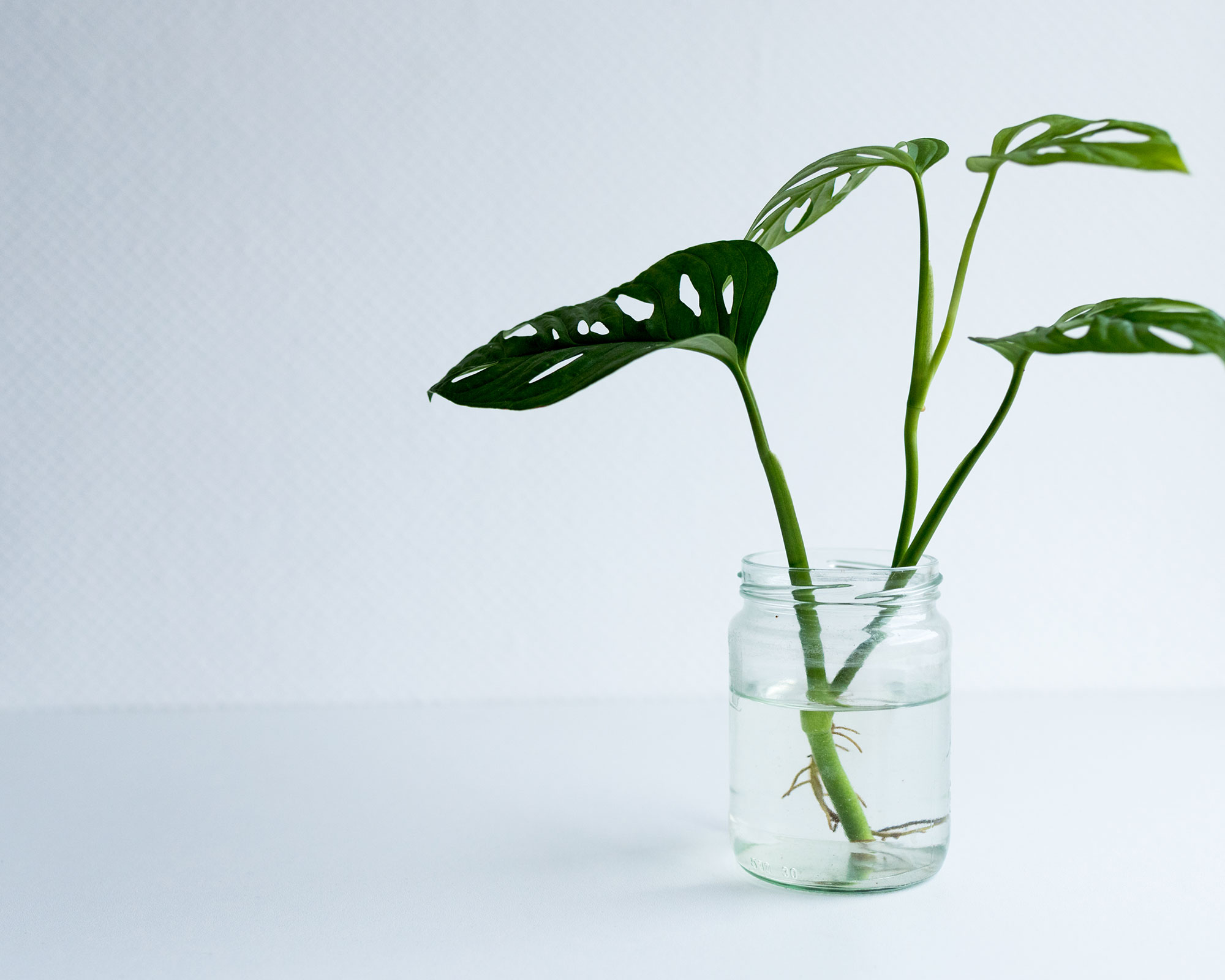
What's a Swiss cheese vine plant?
Less well known, Monstera obliqua (Swiss cheese vine) is different from Monstera deliciosa as its holes appear right from the get-go. They're also an attractive elongated oval shape rather than having ragged edges.
The holes in the regular Swiss cheese plant meanwhile start off life undivided and the holes only form after a while.
The Swiss cheese vine looks great draping out of a sturdy hanging basket. Care is the same for both obliqua and deliciosa varieties but take care when repotting as the leaves can tear.

Monstera obliqua (Swiss cheese vine) loves a hanging basket
Where to buy Swiss cheese plants
Now you know how to care for a Swiss cheese plant you will want one of your own. They’re often available in florists, garden centers and even grocery stores, but you can also shop for them online for an even more convenient option. Our quicklinks will help you start your search.
Shop Swiss cheese plants in the UK:
- Shop Swiss cheese plants at Suttons
- Shop Swiss cheese plants at Amazon
- Shop Swiss cheese plants at Crocus
- Shop Swiss cheese plants at Patch Plants
- Shop Swiss cheese plants at Primrose
- Shop Swiss cheese plants at You Garden
Shop Swiss cheese plants in the US:
- Shop Swiss cheese plants at Amazon
- Shop Swiss cheese plants at Walmart
- Shop Swiss cheese plants at Target

Lifestyle journalist Sarah Wilson has been writing about gardens since 2015. She's written for Gardeningetc.com, Livingetc, Homes & Gardens, Easy Gardens and Modern Gardens magazines. Having studied introductory garden and landscape design, she is currently putting the skills learned to good use in her own space where the dream is establishing a cutting garden.
